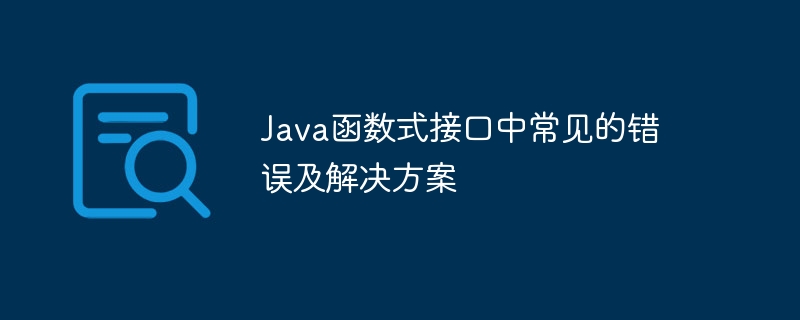Java函数式接口中常见的错误及解决方案(函数.接口.解决方案.错误.常见...)
函数式接口的常见错误包括:未实现接口中的方法返回错误类型在 lambda 表达式中使用捕获变量未抛出声明的异常使用公共方法引用通过避免这些错误,开发者可以有效利用 java 中的函数式接口。

函数式接口是 Java 中的一个重要概念,允许开发者创建接受一个参数并返回一个值的代码块。然而,使用函数式接口时,开发者经常会遇到一些常见的错误。
错误 1:使用未实现的接口@FunctionalInterface
interface MyInterface {
String doSomething(String input);
}
MyInterface myFunction = (input) -> {
// 忘记实现方法体
}; 解决方案:确保实现函数式接口中声明的所有方法。
错误 2:返回错误类型@FunctionalInterface
interface MyInterface {
int doSomething(int input);
}
MyInterface myFunction = (input) -> {
return "Some string"; // 应该返回 int
}; 解决方案:确保方法体返回与函数式接口签名中声明的类型相同的类型。
错误 3:使用 lambda 表达式中的捕获变量@FunctionalInterface
interface MyInterface {
String doSomething(String input);
}
String externalString = "Hello";
MyInterface myFunction = (input) -> {
return input + externalString;
}; 解决方案:避免在 lambda 表达式中使用外部变量,因为它们可能会被意外修改。可以使用局部最终变量来解决这个问题。
错误 4:未抛出声明的异常@FunctionalInterface
interface MyInterface {
void doSomething(String input) throws IOException;
}
MyInterface myFunction = (input) -> {
// 抛出未声明的异常,例如 IllegalArgumentException
throw new IllegalArgumentException("Invalid input");
}; 解决方案:确保lambda 表达式抛出的异常与函数式接口签名中声明的异常类型一致。
错误 5:使用公共方法引用@FunctionalInterface
interface MyInterface {
String doSomething(String input);
}
class MyClass {
public String doSomething(String input) {
return input + "world";
}
}
MyClass myClass = new MyClass();
MyInterface myFunction = myClass::doSomething; 解决方案:避免使用公共方法引用,因为它们可以访问实现类中的私有状态。
实战案例以下是一个使用函数式接口的实际示例:
@FunctionalInterface
interface Calculation {
int calculate(int x, int y);
}
Calculation sum = (x, y) -> x + y;
int result = sum.calculate(5, 10);
System.out.println(result); // 输出:15 通过理解并避免这些常见的错误,开发者可以有效地使用 Java 中的函数式接口。
以上就是Java函数式接口中常见的错误及解决方案的详细内容,更多请关注知识资源分享宝库其它相关文章!
